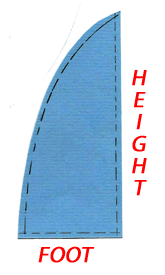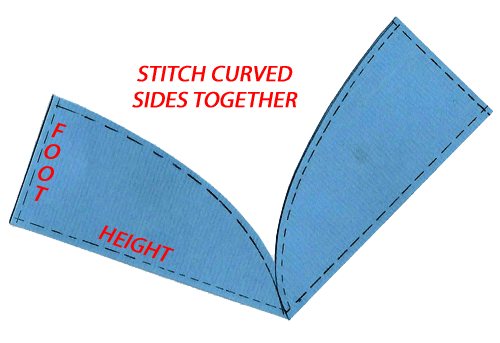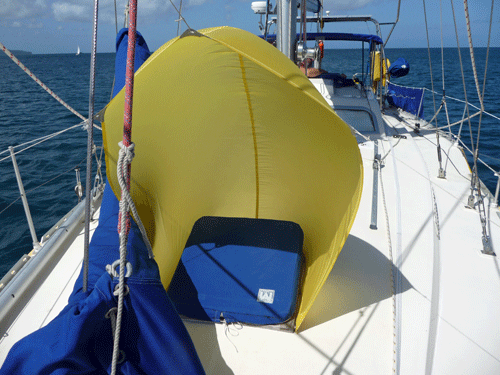An Effective Wind Scoop for your Boat's Fore Hatch
In a nutshell...
Keeping a sailboat cool and comfortable in the tropics relies on a multi-faceted approach. Prioritise non-powered ventilation using wind scoops and cross-breezes to keep air moving. Supplement this with shading (awnings, boom tents) to block solar heat. Finally, use efficient 12V fans for internal circulation and solar fans to exhaust hot, moist air, which is essential for managing humidity and preventing mildew.
At anchor in a hot climate, a wind scoop fitted in you boat's fore hatch will transform living conditions below. There are several different designs available if you want to buy one, but here's a simple and effective version that can be easily and cheaply made up from a single piece of light fabric.
Sadly, I can't take any credit for the design of this; I believe - although I'm not certain - that this should go to the renowned cruising couple, Lynn and Larry Pardy.
As you can see, it's made from two pieces of nylon spinnaker cloth stitched together and attached around the outside of the foredeck hatch surround.
Attached thus, you can close the hatch from below when it starts to rain.
An ordinary domestic sewing machine will be able to handle this easily, but for maximum durability you should use a zig-zag stitch and UV-resistant thread.
How to Make The Wind Scoop
If your hatch is hinged at the forward edge as shown above (the most seaworthy approach), a partially closed hatch - as in the above pic - will still provide ample ventilation whilst preventing rainwater from getting below.
 Measure twice, cut once...
Measure twice, cut once...The first step is to measure the outside dimensions of the fore deck hatch surround - the length and the width - to determine the length of the foot of the wind scoop.
Cutting Out the Two Pieces of the Windscoop
The first piece is shaped as shown below. It's a right-angled triangle, the longest side of which is curved.
 One half of the windscoop...
One half of the windscoop...The length of the foot is half the WIDTH plus the LENGTH of the hatch surround as measured in the first step.
The height is about three times the length of hatch surround - that's usually around 5 feet (1.5m) or so.
The curved edge should approximate to the shape shown. Allow 1" (25mm) all round for seaming.
The second piece is a mirror image of the first one, so use one as a template to draw the other.
Then cut them both out and stitch them together along the curved edge as shown below. Ideally, you'll use a zig-zag stitch for this.
 Cut another one on the opposite hand, and stitch them together. How simple is that?
Cut another one on the opposite hand, and stitch them together. How simple is that?Then turn in the remaining seams and stitch them together. Just two more things to attend to:
- Holding it down and
- Holding it up...
Holding the Wind Scoop Down
On Alacazam, the fore hatch is bedded on a teak surround which makes holding it down with lift-the-dot fasteners a cinch.
Two of these are fitted to each of the three sides, the male part screwed into the surround, and the female part pressed into the seam around the foot of the windscoop. No special tools are needed.
Holding the Wind Scoop Up
Using a halyard to hold it up just doesn't work - you need to hold it both up and forward. First though you need to provide an attachment point on the windscoop for a light line - a short loop of webbing strap stitched on is ideal.
If you're lucky you'll have a convenient forestay, cutter stay or babystay to attach it to. Otherwise you'll have to be a little more creative. One solution would be to take a halyard down to a deck fitting just ahead of the hatch.
You'll find that this wind scoop will direct an impressive breeze throughout the boat which you can vary by adjusting the position of the hatch cover.
Summing Up
Keeping a sailboat cool and comfortable in the tropics relies on a multi-faceted approach. Prioritise non-powered ventilation using wind scoops and cross-breezes to keep air moving. Supplement this with shading (awnings, boom tents) to block solar heat. Finally, use efficient 12V fans for internal circulation and solar fans to exhaust hot, moist air, which is essential for managing humidity and preventing mildew.
This article was written by Dick McClary, RYA Yachtmaster and author of the RYA publications 'Offshore Sailing' and 'Fishing Afloat', member of The Yachting Journalists Association (YJA), and erstwhile member of the Ocean Cruising Club (OCC).
Frequently Asked Questions
1. What are the most effective non-powered methods for ventilating a sailboat in hot, humid climates?
1. What are the most effective non-powered methods for ventilating a sailboat in hot, humid climates?
The most effective non-powered methods involve creating cross-breezes and encouraging airflow. This is best achieved by using wind scoops and dorade vents to capture outside air and direct it below deck, and strategically opening ports and hatches on opposing sides to allow heat and stale air to escape. Companionway screens can also be very effective for maximising airflow while keeping insects out.
2. How can I reduce heat build-up inside the boat during the day?
2. How can I reduce heat build-up inside the boat during the day?
To reduce heat build-up, the primary goal is to minimise solar gain. You should use a cockpit awning or boom tent to shade the deck and cabin top, which are major sources of heat transfer. Additionally, reflective or blackout coverings on portlights and hatches will block direct sunlight, and ensuring lockers and bilges are open allows for air circulation that can prevent pockets of trapped heat.
3. Are solar-powered fans or 12V fans a worthwhile investment for tropical sailing?
3. Are solar-powered fans or 12V fans a worthwhile investment for tropical sailing?
Yes, both are highly worthwhile. Solar-powered exhaust fans (often integrated into deck vents) are excellent for continuously drawing out hot, stale air, even when you're away from the boat, and they use no battery power. Low-draw 12V fans are essential for circulating air inside the cabin, providing a personal breeze, and breaking up stagnant air pockets, which is crucial for comfort and reducing mildew.
4. What is the best way to manage humidity and condensation below deck?
4. What is the best way to manage humidity and condensation below deck?
Managing humidity is key to comfort and preventing mould or mildew. Maximise ventilation to exchange moist indoor air with drier outside air whenever possible. Consider using desiccant materials or moisture traps in closed-off areas like lockers. For prolonged periods, especially when away from the boat, a small dehumidifier (if shore power is available) or a continuously running solar fan can make a significant difference.
5. What are the considerations when deciding between a built-in air conditioning unit and a portable unit?
5. What are the considerations when deciding between a built-in air conditioning unit and a portable unit?
A built-in air conditioning (AC) unit offers superior, consistent cooling and dehumidification across the entire cabin but requires significant engine or generator run-time, substantial battery power (often 230V or 110V systems), and a dedicated through-hull. A portable unit is cheaper, requires no installation, and can be moved, but it is less efficient, only cools a small area, and requires venting hot air out, which can be cumbersome. The choice often comes down to budget, power generation capacity, and how often you will have access to shore power or run a generator.
6. Do sail covers, stack packs, or biminis affect cabin temperature, and how should they be maintained in the tropics?
6. Do sail covers, stack packs, or biminis affect cabin temperature, and how should they be maintained in the tropics?
Yes, they significantly affect temperature. A well-designed bimini or awning provides essential shade, dramatically lowering the temperature below. The fabric itself will absorb heat, so light colours are preferable. Maintenance is critical: regularly wash the canvas to remove salt and mildew, which can degrade the fabric and trap odours. Ensuring there is airflow under the bimini prevents a heat pocket from forming directly over the cockpit.
Recent Articles
-
Optimal Watch Keeping Systems: Rotas, COLREGS & Safety on Passage
Nov 08, 25 06:45 PM
Master the art of Optimal Watch Keeping Systems for safety on passage. Expert-level guide to two & three-person rotas, COLREGS compliance, and technology for vigilance. -
Mastering Offshore Seamanship: Heavy Weather & Safety Protocols
Nov 06, 25 11:43 AM
Expert guide to offshore safety and crew protocols. Master heavy weather tactics, self-steering redundancy, watchkeeping systems & essential personal safety gear. -
Tradewinds Sailing: Optimising Offshore Routes, Rigs & Comfort
Nov 06, 25 11:42 AM
Master the art of Tradewinds Sailing with expert tips on sail configurations, self-steering, and energy management for a comfortable, fast ocean passage.













